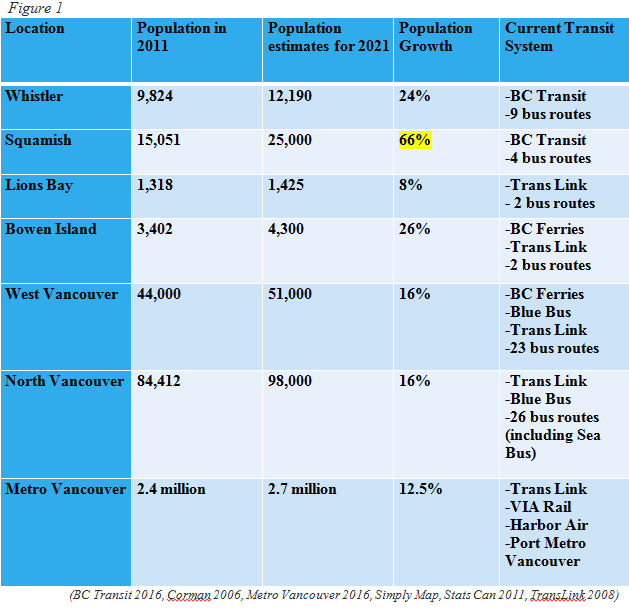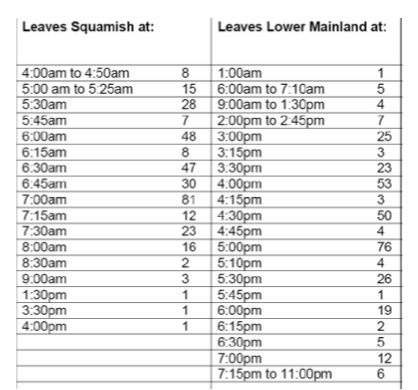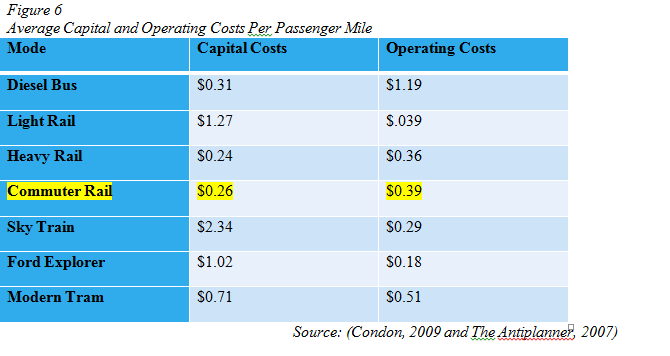![]()
Our goal is to determine the feasibility of a commuter train along the Sea to Sky corridor. The report is in conjunction with GEOG 419, Research in Environmental Geography.
Recommendations
- The District of West Vancouver should implement a commuter train service that travels between Squamish and North Vancouver.
- There should be 3 commuter trains, leaving Squamish at 6:00, 6:30, and 7:00am. The trains would then leave North Vancouver at 4:00, 4:30 and 5:00pm, Monday to Friday.
- A price of $25.22 per passenger would cover the capital and operating costs of the train. However, with taxes, substitutes and investors costs should be reduced to $15 per person.
- Single level tilting cars should be put in operation.
- The train stations should be located at Downtown Squamish, Horseshoe Bay, Dundarave, Park Royal, and Lonsdale Quay.
Review of Communities along the Line
Figure 1 is a review of the communities close to the line in terms of population in 2011, projected population for 2021, and the current transportation systems in the selected locations. A general trend is the significant increase in population in all of the locations. However, what is most significant is Squamish’s projected population growth. In 2011, the population was 15,051 and is projected to reach 25,000 by 2021. This is a potential growth rate of 66%.
Squamish’s massive population projections are partly due to major developments that are planned for the region. For example, Garibaldi at Squamish Ski Resort is projected to create 4000 jobs to operate the resort, have 1,500 hotel rooms, over 2000 residential units and estimates to bring in 730,000 skiers a year (Findlay, 2016). Another major development is Squamish’s Oceanfront. This project is planned to have over 1,100 residential units, and will take more than 2,300 jobs to build. The land for this project has already been sold to the developer as of February 3rd 2016, and is projected to take 20 years to build all 6 phases (Squamish Oceanfront Development Corporation, 2016).
Demand Analysis
The demand analysis will be split up into two case studies.
Case Study- Between Squamish and North Vancouver

Barb the Business woman represents the demographic who live in Squamish where housing is relatively affordable, and commute to work in Metro Vancouver throughout the week. Like Barb, many locals in Squamish are young/ educated families. It is estimated that the medium age in Squamish is 36.8 years old (Stats Can, 2011). Since Barb has lived in Squamish for over 10 years now, she has noticed a dramatic increase in the volume of cars on the highway. It sometimes takes Barb over an hour to get from Squamish to her office in downtown Vancouver, where she then has to pay a heavy premium for parking.
Where are People Travelling in this Region
– It is estimated that there were 1,865 daily southbound commuters from Squamish in 2012 (Seymour, 2001).
– Over 1,300 Squamish Residents work full time in Whistler (AECOM, 2009).
– Traffic peaks along the Sea to Sky highway, just south of Squamish occur at 7:00 – 8:00 am and 4:00 – 5:00pm (AECOM, 2009).
Potential Train Passengers for this Region
The BC Ministry of Transportation and Infrastructure collects traffic data from various locations throughout the province. If we look at a site called Eagles Ridge, just north of Horseshoe Bay, there was a 25% increase in traffic volume in just 5 years. Using this traffic count data, estimates can be determined for the amount of train passengers.
Looking at the numbers above, for the sample dates the base ridership is 495 southbound passengers which is equivalent to 990 total passengers a day. Again this is the base ridership, we suggest a ridership of around 600 people a day per direction, or a total of 1,200 people a day if you consider Squamish’s projected population growth.
Case Study- Between Whistler and Squamish

Sam the Skier represents the tourist demographic and those who live in Whistler. Sam finds getting from Whistler to Squamish a challenging task. Sam grew up abroad and is not accustomed to winter driving conditions and finds the highway is often unreliable due to all the closures. In addition, because Sam works primarily as a ski instructor, buying winter tires for his car is a relatively large expense.
Where are people travelling
-Whistler receives around 2.1 million visitors each year. (Tourism Whistler, 2016).
– Most visitors travel to Whistler in a private vehicle on Highway 99, while others arrive through scheduled bus services that run from YVR more than 10 times daily (Tourism Whistler, 2016).
– Over 1,300 Squamish Residents work full time in Whistler (AECOM, 2009).
Potential Train Passengers for this Region
According to the Ministry’s traffic data for a site just north of Squamish, traffic volumes have increased roughly 25% over the past 10 years. Using traffic count data, estimates can be determined about the number of commuters from Squamish to Whistler. It is notable that most commuters in the area are going Northbound to Whistler in the mornings.
Looking at the numbers above, for the sample dates the base ridership is 273 Northbound passengers, which is equivalent to 546 total passengers a day. These numbers are too low to implement a commuter train service between Squamish and Whistle for now. We recommend implementing a commuter train from Squamish to North Vancouver, see how successful that line is, and then 10 to 20 years in the future relook at the demand analysis for Squamish to Whistler. It is also important to note that a commuter train varies from all day service, if the District of West Vancouver was interested in all day service to Whistler, the demand analysis would have to be altered.
Type of Service
This section will look at when the trains should run, the type of trains, and where the train stations should be located.
When the Trains will run
In 2008, the District of Squamish sent out a survey to 634 residents asking them what times they would want a potential commuter train to leave Squamish and the lower Mainland. According to the results, the best times to have a commuter train leave Squamish would be 6:00, 6:30, and 7:00am and the best times to leave North Vancouver would be 4:00, 4:30 and 5:00pm.
Figure 5
Type of Trains
Ian Fisher, Manager of Planning and Operations for Sky Train indicated that each train car can hold 80 to 100 people. A train car is one unit of a train, where all the cars put together make up the entire train. He explained that each car is approximately 25 meters long by 3 meters wide. We suggest there be 3 trains consisting of 3 cars each. Considering the demand numbers of approximately 600 people per day, per direction, then divide that by 3 trains you get roughly 200 people per train. Technically 200 people can fit into 2 train cars, but then the train would be at maximum capacity. By adding an extra car, it allows the train to respond to future service demands. The Canada Line, for example did not consider future ridership demand as much as it should have when it was built in Vancouver in preparation for the 2010 Olympics. Right now in 2016, the Canada Line is already at maximum capacity, and it would be very costly to increase the size of the prebuild station platforms to service an extra car on each train. Therefore, a potential train service from Squamish to North Vancouver should have platforms of at least 75 meters long at each train station. This way 3 train cars can fit on the stations, and the line will be well suited for future demand.
Ian also suggested that single level tilting cars would be the best type of train for the Sea to Sky corridor. Tilting cars can reduce travel time by 10% to 15%, create a smoother ride resulting in less motion sickness, and can be implemented in a wide variety of options such as diesel or electric. The bullets below show the run time of trains versus a passenger car from Squamish to North Vancouver. A Bud Rail Diesel car is the type of passenger train that used to run along the corridor, until the service ended in 2002.
- Bud Rail Diesel: 80 minutes
- Tilting Cars: 68 minutes
- Passenger Car: 55 minutes
More discussion should be made about the type of train that would run along the corridor. We recommend implementing single level titling cars, however depending on the budget, technology advances and other factors, the District of West Vancouver will make the final decision on the type of train they would like to see implemented on the tracks.
Where Should the Train Stations Be Located
Using Geographic Information System (GIS) software, we were able to determine the best areas for train station locations. In order to do this, we had to collect data from various sources such as Geogratis, Abacus, BC Data, the City of North Vancouver, and the Districts of North Vancouver, West Vancouver and Squamish. We then performed a multi-criteria analysis to determine the best suitability for train station locations. A multi-criteria analysis basically entails weighing different factors that would affect the train station suitability. All of the factors combined must be equal to one. The factors considered in the analysis are shown in the chart below.
If necessary, the weighting and criteria can be altered for the specific needs of the District of West Vancouver.
The images below represent the suitability for train station locations from Squamish to North Vancouver. The areas in red represent the lowest suitability, the areas in yellow represent a medium suitability, and the areas in green represent a high suitability for a station. From this analysis it can be observed that the train stations should be located at: Downtown Squamish, Dundarave, Park Royal, and Lonsdale Quay. Although Horseshoe Bay does not appear in green on the map, we would recommend adding it as a stop since it experiences heavy ferry traffic. In addition, the last stop should be Lonsdale Quay as it has a Sea Bus service that goes directly to downtown Vancouver.
The numbers above are based on maximum capacity. If the modes listed above were not at maximum capacity, the costs would be much higher. Capital costs include acquiring the vehicles and constructing the infrastructure necessary to support them. Capital costs would be much lower along the Sea to Sky corridor since a rail line is already in place.
It is approximately 38.8 miles from the Sea Bus terminal in North Vancouver to Squamish. Therefore, a price of $25.22 per person would apply to cover capital and operating costs for a commuter train to break even.
Transportation services run by the public sector traditionally do not expect to recover their full operating and capital costs from customer fares. For example, the West Coast Express is considered successful by governments even though it recovers only 60% of its costs through passenger fares (Washbrook, 2003). We recommend a price around $15 per passenger, therefore additional funding would have to be provided though taxes, subsidies, and investors.
Cost Analysis- Driving Vs Train

How much does Barb spend on gas and parking during a day in the office?
Hourly rates at Vancouver’s downtown meters and parkades range from $1 to $7 per hour (CBC, 2014). Barb drives a Mazda 3, assuming gas prices in Vancouver are $1.30 a liter, it costs her $7.80 to go 100km on the highway. Barb drives 123km a day to and from work, therefore Barb spends around $35.00 a day on gas and parking, assuming her parking is $3.00/hour and she works 8 hours a day. If the train was $15.00 one way, or a total of $30 for both directions, Barb would save $5 a day. This is a total savings of over $1000 a year. Lets also remember that this does not take into account the actual price of a car and insurance, which is likely to be over $4000 a year.
Benefits of a Train
This section will discuss some of the benefits of a train (Condon, 2010).
- Economic: new business, attracts more events, growth, new investment, enhances the downtown core, more tourists.
- Social: promotes sustainability, active lifestyle, freedom (can get work done on a train), safety, spectacular views, comfort.
- Environmental: cars off the road, enhances the transit network, less demand to widen the highway, less emissions.
Final Recommendations
- The District of West Vancouver should implement a commuter train that travels between Squamish and North Vancouver.
- There should be 3 commuter trains, leaving Squamish at 6:00, 6:30, and 7:00am. The trains would then leave North Vancouver at 4:00, 4:30 and 5:00pm, Monday to Friday.
- A price of $25.22 per passenger would cover capital and operating costs, however with taxes, substitutes and investors the costs should be reduced to $15 per person per commute.
- Single level tilting cars should be put in operation.
- The train stations should be located at Downtown Squamish, Horseshoe Bay, Dundarave, Park Royal, and Lonsdale Quay.







